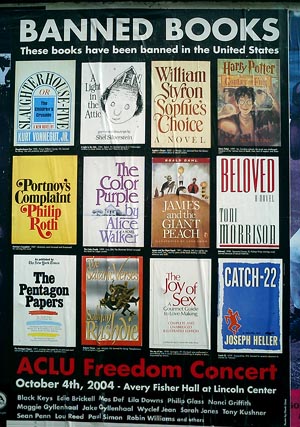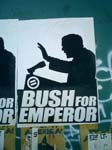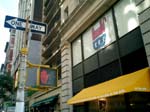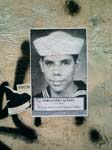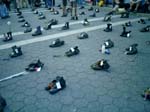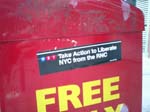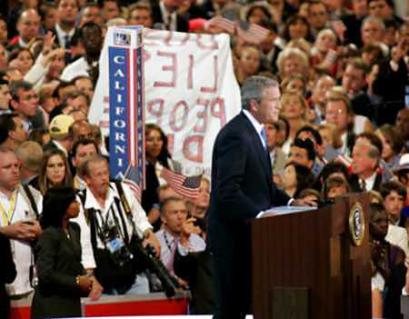posters
Your Logo, Mr. President
Via email:
“Dear John,
I publish a magazine that teaches graphic design, and last Friday we opened an online poll that asks, "Graphically speaking, who has the better campaign poster?" The poll will be open through election day.
http://www.bamagazine.com/BushKerry/
Response was immediate: Bush 4 to 1. We’ve posted a critique of our own.
Thought you might find this up your alley. Madison Avenue knows that good looks can change minds. In a close election, could design make the difference?
Thanks.”
![]()
![]()
A few weeks ago, the New York Times also published an Op-Ed and visual analysis on the subject, followed by subsequent letters to the editor.
But then isn’t talking about a candidate’s poster style a lot like talking about who looks more “Presidential” in a televised debate? It privileges rhetoric over substance, and implies that the candidates are basically the same when they meet on the neutral playing field of design. Who has more “charisma”? Which is more “authentic”? Familiarity with a candidate’s record is irrelevant to look and feel and, subsequently, everyone’s subjective opinion is equally valid.
Which is not to say that rhetoric and impression are not relevant. In such a tight race, small differences do count.
Political Posters, Next 1/4 Mile
For those of you who don’t live in an urban environment or on a college campus, there’s always freeway posters.
Shhh!
Hooray for librarians!
As if there wasn’t enough to thank your librarian for, from Berkely to Madison, Palo Alto to Whatcom County, librarians are taking a stand against the USA Patriot Act.
Via Wired I discovered the work of Jessamyn West a librarian in Rutland, Vermont.
While the Patriot Act says you can not tell patrons if the FBI is monitoring library computers or requesting patron records, it doesn’t say you can not not tell them:
The Vermont Library Association has provided copies of the sign to every library in the state.
Banned in the U.S.A.
Classic book cover design on display in the streets in New York City.
The posters were designed by the artist Chuck Close. You can download high resolution PDFs here and here.
See the American Library Association’s list of 100 most frequently banned books.
Read more about Banned Books campaigns by the ACLU and the ALA, and about the ACLU’s concert event.
Manifesto del Sindicato de Obreros Tecnicos, Pintores y Escultores, 1922
Manifesto issued by the Union of Technical Workers, Painters, and Sculptors, 1922
“Social, Political, and Aesthetic Declaration from the Union of Technical Workers, Painters, and Sculptors to the indigenous races humiliated through centuries; to the soldiers converted into hangmen by their chiefs; to the workers and peasants who are oppressed by the rich; and to the intellectuals who are not servile to the bourgeoisie:
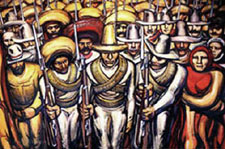 We are with those who seek to overthrow of an old and inhuman system within which you, worker of the soil, produce riches for the overseer and politician, while you starve. Within which you, worker in the city, move the wheels of industries, weave the cloth, and create with your hands the modern comforts enjoyed by the parasites and prostitutes, while your own body is numb and cold. Within which you, Indian soldier, heroically abandon your land and give your life in the eternal hope of liberating your race from the degradations and misery of centuries.
We are with those who seek to overthrow of an old and inhuman system within which you, worker of the soil, produce riches for the overseer and politician, while you starve. Within which you, worker in the city, move the wheels of industries, weave the cloth, and create with your hands the modern comforts enjoyed by the parasites and prostitutes, while your own body is numb and cold. Within which you, Indian soldier, heroically abandon your land and give your life in the eternal hope of liberating your race from the degradations and misery of centuries.
Not only the noble labor but even the smallest manifestations of the material and spiritual vitality of our race spring from our native midst. Its admirable, exceptional, and peculiar ability to create beauty — the art of the Mexican people — is the highest and greatest spiritual expression of the world-tradition which constitutes our most valued heritage. It is great because it surges from the people; it is collective, and our own aesthetic aim is to socialize artistic expression, to destroy bourgeois individualism.
We repudiate the so-called easel art and all such art which springs from ultra-intellectual circles, for it is essentially aristocratic.
We hail the monumental expression of art because such art is public property.
We proclaim that this being the moment of social transformation from a decrepit to a new order, the makers of beauty must invest their greatest efforts in the aim of materializing an art valuable to the people, and our supreme objective in art, which is today an expression for individual pleasure, is to create beauty for all, beauty that enlightens and stirs to struggle.”
David Siqueiros, et al., originally published as a broadside in Mexico City, 1922. Published again in El Machete, no. 7 (Barcelona, June 1924).
English translation from Laurence E. Schmeckebier Modern Mexican Art (Minneapolis: University of Minnesota, 1939), p. 31.
Don’t Let the Door Hit You On the Way Out
The convention is over, but the traces remain — the stories emerge and the protests continue.
Click on an image below to view a larger version.
On the Inside
Via Reuters:
“A protest sign is held up behind U.S. President George W. Bush as he delivers his speech to the delegation during the final night of the 2004 Republican National Convention at Madison Square Garden in New York City on September 2, 2004. The protester was removed from the convention hall by authorities. Photo by Rick Wilking/Reuters”
Grand Central Banner
On August 18, 2004, a group of New Yorkers launched a 15-foot banner suspended by helium balloons in the main concourse of New York’s Grand Central Terminal. The banner read:
NO
BUSH
LIES
WARS
They walked away unhassled, amid cheers.
The banner hung from the Vanderbilt Avenue end of the Terminal’s vaulted ceiling for an entire day, across from the large American Flag hanging above the eastern end of the concourse.
Read more, or just skip to the pictures.
A Place to Live, Breathe, and Work
The Center for the Study of Political Graphics has posted three new online exhibitions of posters from their archives. The collections are organized thematically, around a dozen posters per theme, spanning several decades, countries, and struggles.
Notice the tiny “next” links at the bottom of some of the pages. They’re very easy to miss.
Earth, Wind & Solar
International Ecology Posters
From the site:
 “Global Warming. Arsenic in drinking water. Pesticide Poisoning. Environmental Racism. Nuclear Waste Disposal. Irradiated and Genetically Modified Food. The list is endless. Where pollution is concerned, the world is a global village where no continent, country, or neighborhood is safe. Multinational corporations’ insatiable need for new markets and greater profits consistently overrides environmental concerns, and few governments oppose them. But these posters convey an increasing sense of urgency, as international artists continue to use the power of graphics to organize a frontline of defense against rapidly escalating pollution.”
“Global Warming. Arsenic in drinking water. Pesticide Poisoning. Environmental Racism. Nuclear Waste Disposal. Irradiated and Genetically Modified Food. The list is endless. Where pollution is concerned, the world is a global village where no continent, country, or neighborhood is safe. Multinational corporations’ insatiable need for new markets and greater profits consistently overrides environmental concerns, and few governments oppose them. But these posters convey an increasing sense of urgency, as international artists continue to use the power of graphics to organize a frontline of defense against rapidly escalating pollution.”
The posters are organized as follows:
- Early Environmental Awareness
- Global Warming
- Water Pollution
- Air Pollution
- Deforestation
- Pesticides And G.M.O.s
- Nuclear Power And Waste
- Environmental Disasters
- Environmental Racism
- Martyrs
- Green Alternatives
- Visions For The Future
We Shall Not Be Moved
International Graphics on Gentrification and Homelessness
From the site:
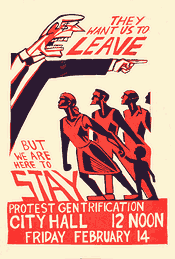 “A missed paycheck, a health crisis, or an unpaid bill are all that separate many people from homelessness. As America’s income gap widens, renters worry if they can ever buy homes of their own—or keep their rentals through retirement. The lack of affordable housing is not just a U.S. problem. We Shall Not Be Moved uses domestic and international posters to show that homelessness and gentrification are major issues throughout the world—and from the U.S. to Europe to Australia, posters remain the resisters’ tools of choice. Posters announce demonstrations to oppose demolitions, support squatters’ rights to move into abandoned buildings, and organize tenants’ unions. They document victories, defeats, and ongoing confrontations. Posters both record these struggles, and are central to them. They show that victory does not happen overnight—it can take years—but it is possible to fight city hall and the developers and win.”
“A missed paycheck, a health crisis, or an unpaid bill are all that separate many people from homelessness. As America’s income gap widens, renters worry if they can ever buy homes of their own—or keep their rentals through retirement. The lack of affordable housing is not just a U.S. problem. We Shall Not Be Moved uses domestic and international posters to show that homelessness and gentrification are major issues throughout the world—and from the U.S. to Europe to Australia, posters remain the resisters’ tools of choice. Posters announce demonstrations to oppose demolitions, support squatters’ rights to move into abandoned buildings, and organize tenants’ unions. They document victories, defeats, and ongoing confrontations. Posters both record these struggles, and are central to them. They show that victory does not happen overnight—it can take years—but it is possible to fight city hall and the developers and win.”
The posters are organized as follows:
- Introduction
- Development & Speculation
- Homelessness & Poverty
- Organizing Resistance
- War & Displacement
- Conclusion
Solidarity Forever!
Graphics of the International Labor Movement
From the site:
 “Organized labor has consistently produced more political graphics than any other domestic movement for social change. Labor posters are often produced in the midst of a strike or boycott and convey the urgency of the times. Others are commemoratives, marking the anniversary of a victory or a martyred labor leader. They remind viewers of a too often hidden history, rally against dangerous conditions in the workplace, and warn that such injustices still occur. Although many of the posters are historical, the issues are not. The eight-hour day is no longer sacrosanct. More and more children are entering the workforce. Pesticides threaten farm workers and consumers. Sweatshops are proliferating domestically and internationally. These graphic expressions of international solidarity are a powerful combination of art and politics, crossing borders of time and place.”
“Organized labor has consistently produced more political graphics than any other domestic movement for social change. Labor posters are often produced in the midst of a strike or boycott and convey the urgency of the times. Others are commemoratives, marking the anniversary of a victory or a martyred labor leader. They remind viewers of a too often hidden history, rally against dangerous conditions in the workplace, and warn that such injustices still occur. Although many of the posters are historical, the issues are not. The eight-hour day is no longer sacrosanct. More and more children are entering the workforce. Pesticides threaten farm workers and consumers. Sweatshops are proliferating domestically and internationally. These graphic expressions of international solidarity are a powerful combination of art and politics, crossing borders of time and place.”
The posters are organized as follows:
Call to Arms!
Rene Wanner has maintained his Poster Page on the Web continuously since August 21, 1997. In May, he started a blog. Yesterday, he noted:
“[August 1] is the 60th anniversary of the Warsaw Uprising against the German occupation in World War II, during which more than 250,000 people were killed and the city was largely destroyed. Some posters made by the insurgents have survived, among them the famous “Call to Arms!” (Do Broni!) by Mieczyslaw Jurgielewicz. A year before, in 1943, the Warsaw Ghetto Uprising which also failed, extinguished the lives of the jewish population of Warsaw, which was about 375,000 before the war.”
...
Also on August 1, 1944, four thousand Roma were gassed and incinerated at Auschwitz-Birkenau. By the end of the war, between 70% and 80% of the Romani population had been annihilated by Nazis. In Romani it is called “the Devouring.”
After the war, no Roma were called to testify at the Nuremberg Trials, and no one came forth to testify on their behalf. No war crimes reparations have been paid to the Roma as a people. And no posters of resistance are known. [source]
page 19 18 17 16 15 14 13 12 11 10 9 8 7 6 5 4 3 2 1 Older »



![The FBI has not been here. [watch very closely for the removal of this sign]](http://backspace.com/notes/images/antipat_sign.png)
